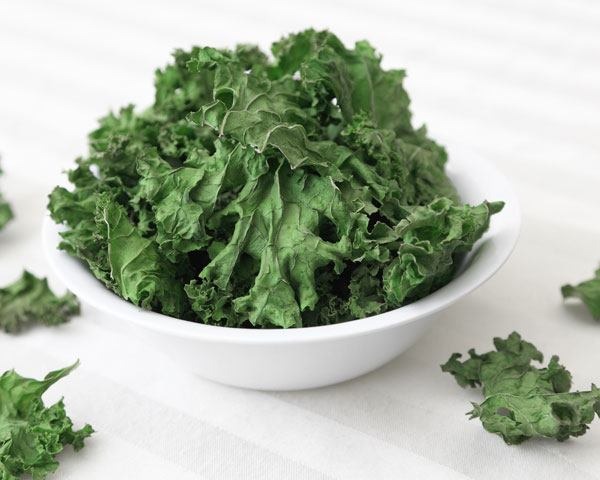What Is Kale?
We may receive a commission on purchases made from links.
On a recent episode of Top Chef: New Orleans, Food & Wine's editor-in-chief Dana Cowin named kale as a trend that she'd like to see disappear. Recently, kale has starred on countless menus in the same salad variations, but to call the leafy vegetable merely a trend is misinformed, as it has had a place in food repertoires worldwide for quite some time. To know more about everything kale-related, we've outlined the basics that you should know.
Firstly, let's get into the nitty-gritty of what kale actually is. Kale, or borecole, is a leafy vegetable with colored leaves that comes in a plethora of different varieties. It exists within the same species — Brassica oleracea — as broccoli, Brussels sprouts, cauliflower, and collard greens. The kale leaves and stems come in diverse colors and shapes, including tall and short, curled and plain leaved, tall-growing, horizontal-growing, and in colors ranging from blue-green to yellow-green to red.
The different varieties have distinctive tastes and appearances. These types include: Curly Green, Ornamental, Redbor, Premier, Siberian, Red Russian, Kamome (available in red, white, and fuchsia), and Lacinato, also known as Dinosaur kale.
In terms of its historical background, kale is a descendant of wild cabbage, which originated in Asia Minor (present-day Turkey), and was later transported to Europe around 600 B.C. The ancient Greeks and Romans grew at least four different types of kale, including the widely known curly green variety. In the Middle Ages, peasants relied heavily on kale as it was hearty enough to grow in colder climates and provided key nutrients in their diets. In the 1600s, English settlers introduced kale into the Americas for the first time.
During World War II, kale appeared in the "Dig for Victory" campaign in England as a superfood because of its high nutritional properties and ease of growth, which was more important than ever during rationing. It would have been prepared by boiling at the time, and perhaps served with heartier vegetables like potatoes or leeks. In present-day America, kale is mostly grown on the East Coast, north of the Mason-Dixie Line, and collards are grown in the Southeastern states. Although kale is a relatively minor commercial crop in the United States, it is a popular winter green in Southern cuisine. Kale is a common addition to winter menus because cold weather makes the crop grow sweeter — kale has a hard time thriving in the heat.
Kale has become popular in recent years because of its high nutritional content; it's rich in both minerals and vitamins. These minerals include copper, iron, and calcium, and the vitamins in kale include carotene, vitamins C, E, B1, B2, and B6, and manganese. This leafy vegetable is also high in fiber, chlorophyll and carotene, notably beta-carotene, lutein, and zeaxanthin. In addition to all of this, kale possesses phytonutrients, which are known to detoxify the body and help fight disease.
In countries all over the world, kale is incorporated into traditional dishes. In Dutch cuisine, it is frequently used in stamppot boerenkool, a hearty potato-kale mash. In Ireland, there is a similar dish called colcannon, which also combines mashed potatoes with kale. In Germany, kale stew is a popular dish that is prepared with sausage — namely pinkelwurst, a specialty Northern German sausage. In Scandinavia, a kale-in-cream side dish called grønlangkål, is commonly served in the winter months. The recipe calls for curly kale, stock, and cream, which are all slowly cooked together for a nutritious and warming dish. In China, Taiwan, and Vietnam, a variety of kale called kai-lan is stir-fried with beef as a main course. In Japan, kale juice, called aojiru, is often consumed as a dietary supplement.
Around five years ago, kale suddenly began popping up on hip New York menus, in restaurants like Barbuto in the West Village and Freemans on the Lower East Side. This trend seems to have coincided with the general move of in-the-know diners and health-conscious eaters toward pursuing clean diets, conscious of dietary restrictions like gluten-free, dairy-free, raw, vegan, vegetarian, and with an emphasis on superfoods.
Kale has become so popular in recent years that a National Kale Day has been proposed, and Dr. Drew Ramsey has even written a cookbook dedicated entirely to the healthy leafy vegetable. Fifty Shades of Kale is not only a cookbook, but also a manifesto in support of kale consumption. The author and Columbia professor argues, though, that the vegetable isn't merely a food trend, but that it's here to stay because it's a staple in so many traditional cuisines worldwide.
Diners across the States have warmed up to the taste of kale and all of its bitter-cabbage charm, and it has definitely held its place on menus for longer than other so-called "food trends." But if kale becomes stale in your food repertoire, we suggest adding other foods into your diet to replace all of the good-for-you benefits of this superfood. Kelp is a great option because it adds a sizable amount of vitamins and minerals to a dish, and has a distinct and unusual flavor. It can be added to soups for its subtle saltiness, to salads for a new texture, or to water in its dry form like Japanese kombu, to make a broth base. Another uncommon but nutritious vegetable that's worth giving a try is kohlrabi, another member of the Brassica family. The bulb tastes similar to radish or jicama, with a touch of green vegetable flavor. The edible leaves can be compared to collards, as to be expected from a relative of kale. Kohlrabi can be prepared cut up and sautéed, or made into a refreshing slaw.
